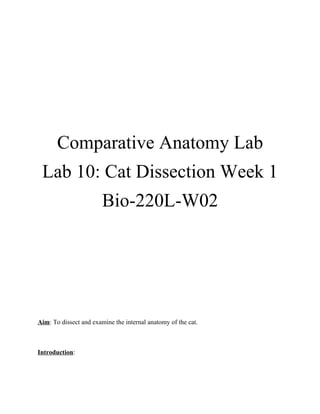
Comparative anatomy
- 1. Comparative Anatomy Lab Lab 10: Cat Dissection Week 1 Bio-220L-W02 Aim: To dissect and examine the internal anatomy of the cat. Introduction:
- 2. This week, we will dissect a cat in order to understand anatomy better. Interesting creatures that they are, cats have many unique characteristics. Their eyes and ears aid them with every move while their coat functions as a blanket in winter and their tongue acts as a comb as well as a warming and cooling device. Cat anatomy is the simple anatomy or consideration of the structure of the internal body parts of a cat. Concisely, as a cat is a carnivore since long times, it has its mouth and claws specially adapted for victimizing the prey. It has the sharpest sense organs for early caution and various other specialties. Cats have highly specialized teeth for the killing of prey and the tearing of meat. The premolar and first molar together compose the carnassial pair on each side of the mouth, which efficiently functions to shear meat like a pair of scissors. While this is present in canids, it is highly developed in felines. The cat's tongue has sharp spines, or papillae, useful for retaining and ripping flesh from a carcass. These papillae are small backward-facing hooks that contain keratin which also assist in their grooming. Like nearly all members of the family Felidae, cats have retractable claws. In their normal, relaxed position, the claws are sheathed with the skin and fur around the toe pads. This keeps the claws sharp by preventing wear from contact with the ground and allows the silent stalking of prey. ats possess rather loose skin; this allows them to turn and confront a predator or another cat in a fight, even when it has a grip on them. This is also an advantage for veterinary purposes, as it simplifies injections. In fact, the lives of cats with kidney failure can sometimes be extended for years by the regular injection of large volumes of fluid subcutaneously, which serves as an alternative to dialysis. Cats possess rather loose skin; this allows them to turn and confront a predator or another cat in a fight, even when it has a grip on them.
- 3. Materials: • Pencil/drawing utensil • White paper • Dissection Kit • Turtle for dissection • Dissection tray • Bleach • Paper towels • Pins • Models labeled “A-G” • Models labeled numbers “1-11” Method: - Obtain everything as instructed. 1. Obtain dissection tray. 2. Clean dissection tray with bleach and wipe dry. 3. Place specimen on the tray dorsally. 4. Take scalpel and cut the specimen starting from the anterior mid-sagittal plane. 5. Identify the structures accordingly. 6. Draw all the models as displayed once the dissection is complete Results/Diagrams:
- 4. - The drawings of all the skeletons and dissections are attached and labeled accordingly. Discussion: Although we did not dissect the cat today, we did examine the external physical features of the cat through the bag that it was enclosed in. In addition, we sketched more models of cats, birds, and reptiles. This provided us with a better understanding of the skeletal anatomy of all of these creatures. The cat is a very complex mammal that shares many characteristics similar to humans. By understanding the cat better, we can better understand humans. Conclusion: Cats are mammals classified as Felis catus under the current scientific classification system. Domestic cats are characterized by a number of well-known physical characteristics. These include a flexible and compact body, keen eyesight and adaptations for visual acuity at night, retractable claws, sharp teeth and a reduction in numbers of teeth reflecting adaptation as a carnivore, long vibrissae, and a long and flexible tail important as an aid to balance. The domestic cat was first classified as Felis catus by Carolus Linnaeus in the tenth edition of his Systema Naturae of 1758. However, because of modernphylogenetics, domestic cats are now usually regarded as another subspecies of the Wildcat Felis silvestris. This has resulted in mixed usage of the terms, as the domestic cat can be called by its subspecies name, Felis silvestris catus. Wildcats have also been referred to as various subspecies of F. catus, but in 2003 the International Commission on Zoological Nomenclature fixed the name for wildcats
- 5. as F. silvestris. The most common name in use for the domestic cat remains F. catus, following a convention for domesticated animals of using the earliest (the senior) synonym proposed. Sometimes the domestic cat is called Felis domesticus or Felis domestica, the term coined by German naturalist Johann Christian Polycarp Erxleben in 1777. These are not valid taxonomic names, and Linnaeus's binomial takes precedence. Cats have 7 cervical vertebrae like almost all mammals, 13 thoracic vertebrae (humans have 12), 7 lumbar vertebrae (humans have 5), 3 sacral vertebrae like most mammals (humans have 5 because of their bipedal posture), and a variable number of caudal vertebrae in the tail (humans retain 3 to 5 caudal vertebrae, fused into an internal coccyx). The extra lumbar and thoracic vertebrae account for the cat's spinal mobility and flexibility. Attached to the spine are 13 ribs, the shoulder, and the pelvis. Unlike human arms, cat forelimbs are attached to the shoulder by free-floating clavicle bones, which allow them to pass their body through any space into which they can fit their heads. No Addendum Questions handed out this week.